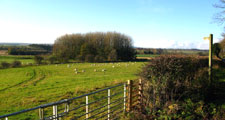Woodland in Tees Lowlands
Existing Woodland
Woodlands are generally sparse in the open landscape of the Tees Lowlands. Narrow ancient semi-natural woodlands are found along the Tees and small farm woodlands are scattered across the area. There are some locally heavily wooded areas associated with parkland and estate landscapes of Windlestone, Hardwick and Sellaby and parts of Raby and Wynyard, and there are tracts of wooded farmland in the Embleton and Hurworth area.
Native Woods
Native woodlands in the Tees lowlands are largely restricted to the banks of the Tees where lowland oak woodlands are found on steep river banks and river terraces, with pockets of lowland ash woodland communities on small limestone outcrops. Lowland oak woodlands are likely to have been more widespread in the past on the glacial boulder clays, sands and gravels and river terrace deposits that cover most the Tees plain. Alder carr woodlands are occasionally found on fertile soils on the margins of ponds and wetlands and these together with valley fen alderwoods are likely to have been more common in the past, and particularly in the flatts and carrs of the River Skerne, the Bishopton and Langley Becks, and along the Tees floodplain.
Characteristic native woodland types in the Wear Lowlands (identified here by their National Vegetation Class) include:
- Lowland Ash Woodland – NVC W8
- Lowland Oak Woodland – W10
- Alder Carr Woodland – W5
- Valley Fen Alder Woodland – W6
- Hawthorn Scrub – W21
- Blackthorn Scrub – W22
- Gorse Scrub – W23
- Bramble Scrub – W24/25
Information on the typical structure and species composition of these particular native woodland communities, distribution and guidelines on their management and suitable sites for new planting can be found by clicking on the links above or by downloading the following PDF:
Native Woodland Types (PDF, 598kb)
Native woods along the Tees have a relatively high degree of connectivity although they are generally small and narrow which limits their value for some woodland species. There are a small number of replanted ancient woods that contain relics of semi-natural vegetation.
Objectives for the area’s existing native woods include:
- Conserving riverside and carr woodlands and improving their management.
- Restoring replanted or modified ancient woodlands.
Plantations
The small farm woodlands scattered across the landscape are very variable in character and include both broadleaved, mixed and coniferous plantations. Most probably have their origins in the 18th and 19th centuries. The larger and more numerous plantations of wooded parklands are also very diverse in character and often contain more ornamental and exotic species. Many of the estate woodlands of the Tees Vale in the west are managed under Woodland Grant Scheme contracts. Take-up elsewhere is generally low suggesting relatively low levels of active woodland management. The principal objective for the management of plantations in the Tees Lowlands is to bring more woodlands into active management.
New Woodland
Planting Sites
Priorities for new woodland planting in the Tees Lowlands include:
Creating new native oak and alder carr woods and particularly where they would contribute to wildlife goals – for example by extending or linking isolated ancient woods.
As many of the area’s native woods are small and narrow fragments, planting on adjacent land – the floodplain or river terraces – can help make these woodlands more robust. The lowlands also contain many areas of flat and poorly drained land where new wet woodlands, a BAP priority habitat, could be established.
Re-establishing bank side vegetation.
The Tees Lowlands are drained by numerous small watercourses where bank side vegetation is generally sparse. Establishing new river and streamside woods can help buffer watercourses from agricultural activities and improve water quality.
Creating new community woodlands and particularly close to larger settlements.
The Tees lowlands in County Durham are generally sparsely populated but contains larger settlements such as Sedgefield and Newton Aycliffe. Planting community woodlands close to urban populations can provide an important recreational resource.
Planting Design
The flat or rolling landscape of the plain can accommodate both large and small woodlands. Form and shape are less important here than in upland landscapes as it is generally the perimeter of woodlands that is most visible. Woodland boundaries should respect the surrounding field patterns where these are strong and respond to the local topography. Consideration should be given to local skylines and landmarks.
Species Selection
The Tees Lowlands does not have much of tradition of commercial forestry and softwoods in particular are not characteristic features of the landscape. Many of the priorities for new woodland planting are for new native woodlands. For these, existing native woodland types can be used as a guide to species selection.
Over most of the Tees Plain lowland oak woodlands (NVC W10) are the most appropriate models for new native woodland planting on typical agricultural soils, with ash woodlands (NVC W8) restricted to occasional and very localised carboniferous limestone exposures along the Tees, and localised outcrops of Permian limestone in the Ingleton and Killerby areas. There may be opportunities to develop alder woodlands (NVC W5 and W6) on wet eutrophic sites along watercourses, around wetlands, and on alluvial floodplains and flat carr land.
Given the fertile soils of the area opportunities exist for the production of good quality hardwoods with planting mixtures designed for silvicultural purposes. Where possible these should use the native broadleaved species found in the native woodlands associated with the lowland landscape.
The area is predominantly arable and close to potential markets for wood-fuel products such as short rotation coppice. This requires the use of specific willow and poplar cultivars. The use of a permanent infrastructure of native woodland in short rotation plantations can help assimilate them into the local landscape and provide benefits to wildlife.
Further Information
- View an interactive map of the distribution of Native Woodland Types in County Durham.



